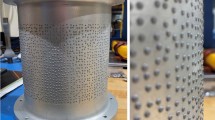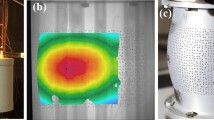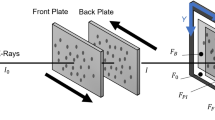Abstract
Digital Image Correlation (DIC) is a well-established, non-contact diagnostic technique used to measure shape, displacement and strain of a solid specimen subjected to loading or deformation. However, measurements using standard DIC can have significant errors or be completely infeasible in challenging experiments, such as explosive, combustion, or fluid-structure interaction applications, where beam-steering due to index of refraction variation biases measurements or where the sample is engulfed in flames or soot. To address these challenges, we propose using X-ray imaging instead of visible light imaging for stereo-DIC, since refraction of X-rays is negligible in many situations, and X-rays can penetrate occluding material. Two methods of creating an appropriate pattern for X-ray DIC are presented, both based on adding a dense material in a random speckle pattern on top of a less-dense specimen. A standard dot-calibration target is adapted for X-ray imaging, allowing the common bundle-adjustment calibration process in commercial stereo-DIC software to be used. High-quality X-ray images with sufficient signal-to-noise ratios for DIC are obtained for aluminum specimens with thickness up to 22.2 mm, with a speckle pattern thickness of only 80 μm of tantalum. The accuracy and precision of X-ray DIC measurements are verified through simultaneous optical and X-ray stereo-DIC measurements during rigid in-plane and out-of-plane translations, where errors in the X-ray DIC displacements were approximately 2–10 μm for applied displacements up to 20 mm. Finally, a vast reduction in measurement error—5–20 times reduction of displacement error and 2–3 times reduction of strain error—is demonstrated, by comparing X-ray and optical DIC when a hot plate induced a heterogeneous index of refraction field in the air between the specimen and the imaging systems. Collectively, these results show the feasibility of using X-ray-based stereo-DIC for non-contact measurements in exacting experimental conditions, where optical DIC cannot be used.














Similar content being viewed by others
Notes
In the literature, X2D-DIC has also been called “digital speckle photography”, “digital speckle radiography”, or “texture correlation”.
Laser-printed patterns on paper can suffer from dithering, where the borders of the speckles are polluted by small droplets of ink. In some situations, this can cause spatial aliasing in digital images of the speckle pattern. However, these spurious features were measured with a high-magnification, high-resolution image to be approximately 85 μm or smaller. Additionally, the lens system resolution was measured to be 7 lp/mm, which translates to a smallest resolvable feature of 70 μm. Therefore, the lens acts as an analog filter, filtering the small features on the edges of the speckles, leading to unaliased speckles in the images used for optical DIC.
References
Sutton MA, Orteu JJ, Schreier H (2009) Image correlation for shape, motion, and deformation measurements: basic concepts, theory, and applications. Springer US
Sutton M A, Wolters W J, Peters W H, Ranson W F, McNeill S R (1983) Determination of displacements using an improved digital correlation method. Image Vision Comput 1(3):133–139
International Digital Image Correlation Society, Jones EMC, Iadicola MA (2018) A good practices guide for digital image correlation, 1 edn. https://doi.org/10.32720/idics/gpg.ed1
Smith CM, Hoehler MS (2018) Imaging through fire using narrow-spectrum illumination. Fire Technol 54:1705–1723
Jones EMC, Reu P (2018) Distortion of digital image correlation (DIC) displacements and strains from heat waves. Exp Mech 58:1133–1159
Abotula S, Heeder N, Chona R, Shukla A (2014) Dynamic thermo-mechanical response of Hastelloy X to shock wave loading. Exp Mech 54:279–291
Pan B, Wu D, Wang Z, Xia Y (2011) High-temperature digital image correlation method for full-field deformation measurement at 1200c. Meas Sci Technol 22:1–11
Gupta S, Parameswaran V, Sutton M A, Shukla A (2014) Study of dynamic underwater implosion mechanics using digital image correlation. Proc R Soc A 470:1–17
Reu P, Miller TJ (2008) The application of high-speed digital image correlation. J Strain Anal 43:673–688
Pankow M, Justusson B, Waas A M (2010) Three-dimensional digital image correlation technique using single high-speed camera for measureming large out-of-plane displacements at high framing rates. Appl Opt 49 (17):3418–3427
Lynch KP, Jones EMC, Wagner JL (2018) Simultaneous PSP and surface deformation measurements for fluid-structure interactions in a shock tube. In: 2018 fluid dynamics conference, AIAA AVIATION forum. AIAA, pp 2018–3870
Giovannetti LM, Banks J, Turnock SR, Boyd SW (2017) Uncertainty assessment of coupled digital image correlation and particle image velocimetry for fluid-structure interaction wind tunnel experiments. J Fluid Struct 68:125–140
Spottswood SM, Beberniss TJ, Eason TG, Perez RA, Donbar JM, Ehrhardt DA, Riley ZB (2018) Exploring the response of a thin, flexible panel to shock-turbulent boundary-layer interactions. J Sound Vib. https://doi.org/10.1016/j.jsv.2018.11.035
Henke BL, Guillikson EM, Davis JC (1993) X-ray interactions: photoabsorption, scattering, transmission, and reflection at E = 50–30,000 eV, Z = 1–92. Atom Data Nucl Data 54:181–342
Thompson A, Attwood D, Guillikson EM, Howells M, Kim K-J, Kirz J, Kortright J, Lindau I, Liu Y, Pianetta P, Robinson A, Scofield J, Underwood J, Williams G, Winick H (2009) X-ray data booklet. Available online: http://xdb.lbl.gov/. Accessed 2018-05-10. National Lawence Berkeley National Laboratory
Chantler CT, Olsen K, Dragoset RA, Chang J, Kishore AR, Kotochigova SA, Zucker DS (2000) X-ray form factor, attenuation and scattering tables, 2005. Version 2.1. Available online: http://physics.nist.gov/ffast. Accessed 2018-05-10. National Institute of Standards and Technology, Gaithersburg, MD. Originally published as Chantler, C.T., J. Phys. Chem. Ref. Data 29(4), 597–1048 (2000); and Chantler, C.T., J. Phys. Chem. Ref. Data 24, 71–643 (1995)
Hubbell JH, Seltzer SM (2018) X-ray mass attenuation coefficients. NIST Standard Reference Database 126. https://www.nist.gov/pml/x-ray-mass-attenuation-coefficients Accessed Nov 2018
Russell SS, Sutton MA (1989) Strain-field analysis acquired through correlation of X-ray radiographs of a fiber-reinforced composite laminate. Exp Mech 29(2):237–240
Synnergren P, Goldrein HT, Proud WG (1999) Application of digital speckle photography to flash x-ray studies of internal deformation fields in impact experiments. Appl Opt 38(19):4030–4036
Prentice HJ, Proud WG, Walley SM, Field JE (2010) The use of digital speckle radiography to study the ballistic deformation of a polymer bounded sugar (an explosive simulant). Int J Impact Eng 37:1113–1120
Grantham SG, Goldrein HT, Proud WG, Field JE (2003) Digital speckle radiography—a new ballistic measurement technique. Imaging Sci J 51(3):175–186
Rae P J, Williamson D M, Addiss J (2011) A comparison of 3 digital image correlation techniques on necessarily suboptimal random patterns recorded by x-ray. Exp Mech 51(4):467–477
Louis L, Wong T-F, Baud P (2007) Imaging strain localization by X-ray radiography and digital image correlation: deformation bands in Rothbach sandstone. J Struct Geol 29:129–140
Bay BK (1995) Texture correlation: a method for the measurement of detailed strain distributions within trabecular bone. J Orthop Res 13:258–267
Synnergren P, Goldrein HT (1999) Dynamic measurements of internal three-dimensional displacement fields with digital speckle photography and flash x-rays. Appl Opt 38(28):5956–5961
Bay BK, Smith TS, Fyhrie DP, Saad M (1999) Digital volume correlation: three-dimensional strain mapping using x-ray tomography. Exp Mech 39(3):217–226
Bay BK (2008) Methods and applications of digital volume correlation. J Strain Anal 43:745–760
Croom B P, Jin H, Mills B, Li X (2019) Effect of fragile speckle patterns on accuracy of digital volume correlation. Exp Mech. https://doi.org/10.1007/s11340-019-00512-4
An introduction to thermal spray. BRO-0005.6, 2016. Available online: https://www.oerlikon.com/metco/en/products-services/coating-equipment/thermal-spray/processes/. Accessed 2018-05-10. Oerlikon Metco
Davis JR (2004) Handbook of thermal spray technology. ASM International
Reu P (2014) All about speckles: speckle size measurement. Exp Tech 38(6):1–2
Miller TJ, Quintana EC (2013) Stereo x-ray system calibration for three-dimensional measurements. Available online: https://prod.sandia.gov/techlib/auth-required.cgi/2013/132097c.pdf. Accessed 2018-05-10
Li N, Sutton M A, Li X, Schreier H W (2008) Full-field thermal deformation measurements in a scanning electron microscope by 2d digital image correlation. Exp Mech 48(5):635–646
Xu Z-H, Li X-D, Sutton M A, Li N (2008) Drift and spatial distortion elimination in atomic force microscopy images by the digital image correlation technique. J Strain Anal Eng 43(8):729–743
Zhu T, Sutton M A, Li N, Orteu J J, Cornille N, Li X, Reynolds A P (2011) Quantitative stereovision in a scanning electron microscope. Exp Mech 51(1):97–109
Maraghechi S, Hoefnagels J P M, Peerlings R H J, Rokoš O, Geers M G D (2019) Correction of scanning electron microscope imaging artifacts in a novel digital image correlation framework. Exp Mech 59 (4):489–516
Acknowledgments
The authors gratefully acknowledge David Saiz for measurements of the tantalum speckle coating thickness, Andrew Miller and Dr. Andrew Vackel for creating the tantalum speckle pattern using thermal spray, Andrew Lentfer for X-ray imaging and for creating the tungsten speckle pattern using tungsten powder mixed in paint, Paul Farias for creating the drawings of the mask for thermal spray, and Dr. Kyle Lynch and Dr. Benjamin Halls for insightful discussion.
This work was supported by the Laboratory Directed Research and Development program at Sandia National Laboratories, a multimission laboratory managed and operated by National Technology and Engineering Solutions of Sandia, LLC, a wholly owned subsidiary of Honeywell International Inc., for the U.S. Department of Energy’s National Nuclear Security Administration under contract DE-NA0003525. This paper describes objective technical results and analysis. Any subjective views or opinions that might be expressed in the paper do not necessarily represent the views of the U.S. Department of Energy or the United States Government.
Author information
Authors and Affiliations
Corresponding author
Ethics declarations
Conflict of Interest
On behalf of all authors, the corresponding author states that there is no conflict of interest.
Additional information
Publisher’s Note
Springer Nature remains neutral with regard to jurisdictional claims in published maps and institutional affiliations.
Rights and permissions
About this article
Cite this article
Jones, E., Quintana, E., Reu, P. et al. X-Ray Stereo Digital Image Correlation. Exp Tech 44, 159–174 (2020). https://doi.org/10.1007/s40799-019-00339-7
Received:
Accepted:
Published:
Issue Date:
DOI: https://doi.org/10.1007/s40799-019-00339-7




